
37 minute read
ATHLETE
SPORTS
YALE FIGURE SKATING CLUB
Advertisement
NEGOTIATING MOVE TO QUINNIPIAC After enjoying a presence at Yale’s Ingalls Rink for over 40 years, the Yale Figure Skating Club has been negotiating with Quinnipiac University to move the skating club’s home away from Yale, largely due to f nancial reasons, to the People’s United Center in Hamden. For more, see goydn.com/YDNsports.
INSIDE YALE-UCONN FOOTBALL
BACKGROUND ON THE IN-STATE RIVALRY When the two schools meet for the 50th time at Rentschler Field in October, UConn will pay Yale $285,000, according to public records obtained by the News. Despite not playing since 1998, the in-state rivalry thrived for a half century before UConn’s divisional realignment. For more, see goydn.com/YDNsports.
FOR MORE SPORTS CONTENT, VISIT OUR WEB SITE
goydn.com/YDNsports Twitter: @YDNSports
YALE DAILY NEWS · FRIDAY, FEBRUARY 19, 2020 · yaledailynews.com
"I think there is some confusion and disappointment with the timing of the [Ivy League grad waiver] since most deadlines for grad school have passed.”
WILL LAIRD ’22
YALE CROSS COUNTRY RUNNER
Behind the Venue: Cullman-Heyman Tennis Center
ANASTHASIA SHILOV AND ZULLY ARIAS/ILLUSTRATIONS AND PRODUCTION & DESIGN EDITORS
The Cullman-Heyman Tennis Center has evolved to set the standards for collegiate tennis.
BY HAMERA SHABBIR CONTRIBUTING REPORTER
Until the Cullman Courts opened on Nov. 13, 1972, Yale was the only Ivy League institution without indoor tennis facilities. Thirty-six years and a renovation later, the Cullman-Heyman Tennis Center would tie with the University of Pennsylvania for the most indoor courts in the Ivy League.
THE HISTORY
Portraits of Yale’s tennis teams — stretching back over 100 years on the men’s side — line the renovated walls of the Cary Leeds lobby. In place of the 1904 team, a sign reads: "A thorough search in 2008 was unable to locate a team portrait," and several scattered sheets declare the absence of formal competition during the World Wars. Above the trophy displays and reaching across the lobby are rows of banners hanging from the ceiling featuring notable Yale tennis players. Those featured include recent graduates, players from the 19th century, all-American winners and Davis Cup champions.
“The history is very obvious when you go into the building,” men’s player Cody Lin ’22 said.
The center received its name after being initially constructed through a generous donation from Joseph Cullman III ’35 and then renovated through a donation ef ort led by Samuel J. Heyman ’60. The facility has served generations of Yale men’s and women’s tennis teams and hosted prestigious tournaments, both for collegiate and professional players. Lauded as one of the best collegiate facilities by architectural critics, coaches and players, it continues to play an integral role in the history of Yale athletics and serve as an amenity to the larger Yale community.
Commissioned through a matching donation from Cullman and bearing the name of his father, Joseph Cullman Jr., class of 1904, the original Cullman Courts complex cost $400,000 to build, nearly $2.5 million in today’s dollars. Herbert Newman designed the facility with functionality and cost minimization in mind as the University experienced financial issues. The project and donor were kept secret until a contractor accidentally leaked building details to bidders. Local newspapers and the News reported the information before the University made a statement announcing the complex’s forthcoming construction.
Prior to the construction of the center, Payne Whitney Gymnasium’s amphitheater and facilities in Bethany and Cheshire hosted indoor tennis play for Yale. The complex was built near the athletic fi elds, and for nine years it was Yale’s newest athletics facility until Reese Stadium opened in 1981.
The location of the center makes viewership scarce, however.
“Since the athletic fields are far from campus, we have a lot fewer fans than we could have, and we defi nitely have to keep encouraging people to come support. That’s always been a challenge for us,” Lin said.
On opening day in 1972, undergraduate students paid $1.50 or $0.75 for singles and doubles to play recreationally on the courts, while faculty and staf rates were decided by prime hours and could range from $2.50 for prime-time singles to $1 for non-prime doubles. During the
SEE VENUE PAGE 10
Ivy League rule exception evokes confusion, hope
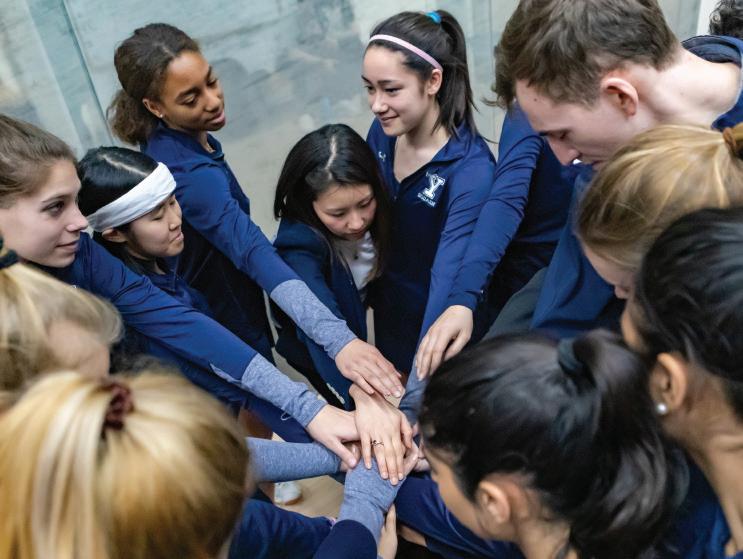
COURTESY OF MUSCOSPORTSPHOTO.COM
A new waiver will allow seniors an additional year of eligibility if they are accepted into a degree-granting graduate program.
BY EUGENIO GARZA GARCÍA AND JAMES RICHARDSON STAFF REPORTERS
On Thursday, the Ivy League confirmed with the News that graduating senior student-athletes will now be permitted to compete as graduate students at their current Ivy institutions during the 2020-21 academic year, granted that they have been accepted into a degree-granting graduate program. IVY LEAGUE
Upperclassmen athletes shared a range of emotions with the News in response to the change, yet one question appeared ubiquitous: Why was the decision announced after most graduate application deadlines had passed? According to the admissions page for Yale’s Graduate School of Arts and Sciences, deadlines for more than 50 programs passed in either December or January.
“I think it’s a good thing that the Ivy League is reevaluating some of their rules due to COVID-19 and they’re trying to support the student athletes,” cross country runner Will Laird ’22 said. “From talking with other athletes at Yale, I think there is some confusion and disappointment with the timing of the announcement since most deadlines for grad school have passed … But all things considered, the rule still will allow more student athletes to participate in the Ivy League which is always good.”
When asked for comment on the timing of the policy change and the reasoning that led to the rule switch, Ivy League Associate Executive Director Matt Panto wrote in an email to the News that the Ancient Eight does not comment on the Council of Presidents’ discussions.
One athlete who is set to benefit from the waiver is wom-
SEE REACTIONS PAGE 10
Ivy League spring-sport competition canceled
BY EUGENIO GARZA GARCÍA STAFF REPORTER
Early Thursday afternoon, the Ivy League announced that it would not hold a spring sports season this year.
IVY LEAGUE
In an email sent to Yale’s spring sport student-athletes just after 1 p.m., Director of Athletics Vicky Chun included a memo from the Ivy League that announced the cancellation of Ancient Eight spring sports competition for the 2021 season. Despite the cancellation of all league competition, the Council of Presidents noted that local spring nonconference competition could happen should the state of the pandemic “substantially improve.”
The Ivy League of ce published an of cial press release a few minutes after Chun’s email to the Bulldogs’ spring athletes.
“As campus and community leaders, we believe that our public health responsibilities and educational principles preclude us from sponsoring Ivy League athlet-
SEE IVY PAGE 10

COURTESY OF YALE ATHLETICS
Last November, the Ivy League announced its initial decision to postpone spring sports through at least the end of February.
Former Yale defenseman settles in at BC
BY TRISHA NGUYEN AND AMELIA LOWER STAFF REPORTERS
Jack St. Ivany, a junior defenseman from Manhattan Beach, California, recently decided to continue his ice hockey career at Boston College, leaving Yale’s team amid the restrictions on practice and competition implemented by the Ivy League. HOCKEY
The two-way defenseman joined the BC team after their sixth game of their season, picking up his fi rst goal at the University of Connecticut on Jan. 23 with an empty-netter from his own zone and posting his fi rst two assists against Merrimack on Jan. 16-17, according to the Eagles Hockey game notes.
While he had no plans of transferring to BC prior to the Ivy League’s cancellation of winter sports, St. Ivany described the shift in his expectations and his main motivation to take the leap of joining a new team.
“At Yale, in the fall, our team was very focused and determined on being ready for whatever kind of season we were given … and [we] really believed we were going to have a season,” St. Ivany said. “Once the Ivy League came out with their decision, my family and I felt it would be best for my development to fi nd a way for me to play games this sea-

COURTESY OF MUSCOSPORTSPHOTOS.COM
Jack St. Ivany transferred to Boston College in January due to the cancellation of the Ivy League’s winter athletic season.
son. I did not feel I was ready to play professional hockey, so we made the decision to look into transferring to another university.”
The ability to participate in gameplay with the Eagles was appealing to St. Ivany, who told the News that the period of time between March 2020 and January 2021 was the longest amount of time that he had taken of from competition.
St. Ivany has had a solid start with the Eagles, having played 11 games and recording a total of four points so far in his BC career. While donning the Blue and White, he played in 62 contests, earning a total of 30 points, with seven goals and 23 assists.
“It was a very long 10-month of season for me and while you can practice skills and train in the gym, there really is nothing like actually playing a game,” St. Ivany said. “So far I have been working to improve all aspects of my game, but I have been putting a lot of time into bettering my skating abilities.”
Transitioning from Yale to BC, St. Ivany described the dif erences in practice protocols in regard to the current health situation. BC tests and monitors the health of their athletes, in addition to using a “tracking system” to monitor its men’s ice hockey players on and of the ice for better contact tracing.
St. Ivany also noticed a change in his new team’s dynamic compared to his former squad.
“I have really enjoyed getting to know the team so far, they were very welcoming to me,” St.
SEE HOCKEY PAGE 10
WEEKEND
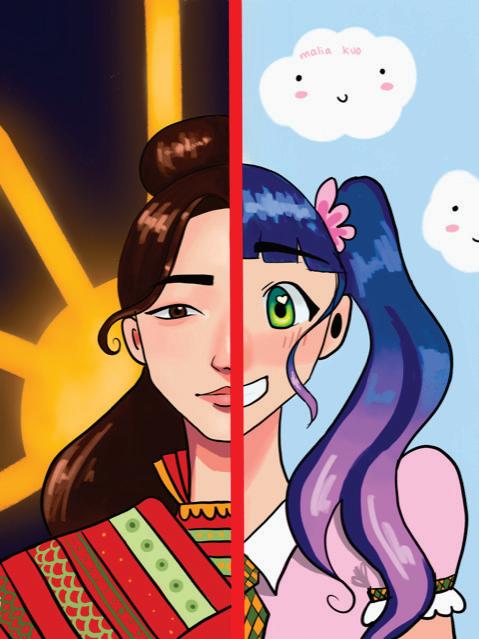
// MALIA KUO
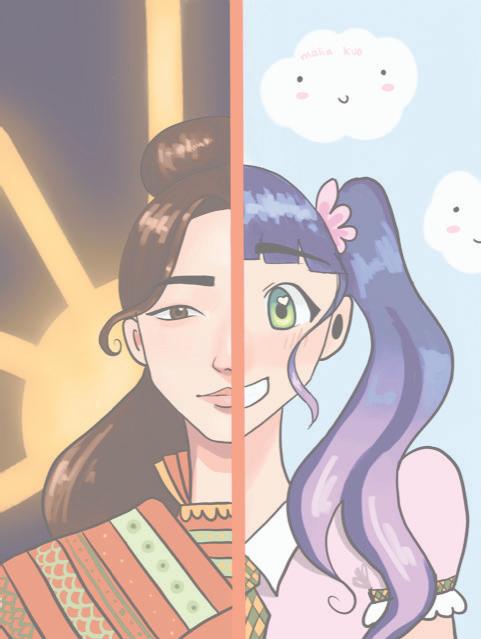
Waifu or Wai-Fools Fetishize Japanese Women
// BY MALIA KUO AND HANAÉ YOSHIDA
Big eyes, bigger tits. Now that we have your attention, let’s talk about the fetishization of Japanese women.
“You’re so cute!”
“I love your features!”
“Do you watch anime? I’m obsessed with anime.”
“I’ve only dated Asians”
“I’ve never dated a Japanese girl before”
“I’m looking for a waifu” barf
As women of Japanese descent, we hear these unprompted, uncalled-for phrases on the regular. We have watched many a relationship or talking stage crash and burn because yet another guy only wants our bodies for his weeboo fantasies. Realizing that the boy you’re starting to fall for is weirdly turned on by your “exotic aura” and couldn’t give a damn about you beyond your race is a special fl avor of disgusting. In public and the pursuit of love, not only does being Japanese become a personality trait, it often becomes the only one that actually matters to other people.
In our time as best friends and talented Japanese women extraordinaires, we have often talked about our endless frustrations with being regularly fetishized and objectifi ed. Why did he beg me to speak Japanese? He really thought I would be his “personal geisha”? What does that even mean? Will we have to spend the rest of our lives having to screen every guy we meet for yellow fever or an anime girl fetish?
But the main question we asked ourselves was “Why is this happening?” After all, Japan was the dominant force of terrifying imperialism and brutal subjugation less than a century ago. Simply put, Japan was the closest thing Asia had to white people… As in, they colonized everything. China. The Philippines, Taiwan, Vietnam. You name it, Japan has made moves on it. If there was ever an Asian country the European nations have considered their equal in enforcing cultural and racial hierarchy, Japan would be it. So, why aren’t Westerners fetishizing Japanese women for their massive traps and unbridled cruelty?
Japan has always been a nation that has captured the attention of the West. Complete with a 250-year isolation period, Japan is the defi nition of playing hard to get, cultivating the image of a mysterious, almost mythical land of refi ned society and epic tales of warfare. The debilitating defeat of the Japanese Empire in World War II did not destroy this fascination with Japan; instead, it created the perfect blank canvas for one of the most successful rebranding campaigns in human history. Japan could become whatever it wanted to, so it became what would sell.
Japan’s buzzword for their rebranding was “utopia.” Become more streamlined, more sleek, more advanced — create the facade of a futuristic society, when in reality, the innovation was just a temporary means to an economic end.
It started with Japan’s so-called “economic miracle.”
Following the war, Japan’s entire industrial bases were completely destroyed. The subsequent creation of newer, more efficient machines outcompeted foreign industrial complexes. This, coupled with the creation of a consumer economy and more streamlined work ef ciency, thrusted Japan into direct competition with some of the world’s greatest economies. Westerners were shocked by this revolution — Japan was pumping out innovation faster than ever, constantly, because of the crippling internal competition in the Japanese market. Mitsubishi, Toyota, Lexus and Honda took the automobile industry by storm. Electronics were exported worldwide. Japan seemed like the future.
And maybe thanks to Japan’s technological reputation, the main export of Japan became culture. And this is where the fetishization of its women comes in.
It all comes down to the mega-success of exporting kawaii culture and anime. Kawaii (“cute” in Japanese) is the cultural force that brought the world everything from Hello Kitty to the Lolita fashion trend to the sexy schoolgirl trope. And of course, anime.
From “HunterxHunter” to “Ouran High School Host Club,” anime has become a global obsession, reaching some 87.2 percent of the world’s population according to the Association of Japanese Animations. It’s an incredible medium, blending heartfelt and engaging storylines with captivating animation. It epitomizes the image that Japan is projecting — exciting, creative and very consumable. And yet, through anime and kawaii culture, Japan has also found a way to rebrand its misogyny. Contrary to common belief, Japanese culture is every bit as fueled by sexism and male dominance as our own. With those values in mind, Japan has created the perfect commodity: the innocent, submissive Japanese woman who is blissfully unaware of her made-for-men body.
Yes, who hasn’t seen the anime waifu running with toast in her mouth because she’s late for class, the bounce catapulting her gargantuan breasts to nearly cover her face? Her schoolgirl skirt is just small enough to show the bottom of her ass, but she blushes shyly when the main character even looks at her. Through animations like these, it’s clear how anime is catered toward the “male gaze.” Japan knows what sells, after all, and what sells is this sexualized, near pedophilic puppet of the Japanese woman.
And of course, with global consumption of Japanese social culture, this male fantasy is what most Westerners imagine when it comes to Japanese women. And then Westerners started fetishizing us. Great. Looks like our dating lives and sanity have been sacrifi ced for Japan’s reputation.
Of course, no country wants to be known as THAT imperialist oppressor. The U.K. will take Harry Styles, hating on Prince Charles and chav checks every day of the week over remembering the millions of deaths at the hands of the British Empire. The French will settle for their berets and baguettes if they get to forget the damage they wrecked in Africa. And don’t even get us started on America.
But no country has been as revolutionary in their rebranding as Japan in the 20th century, and hell, props to the motherland for fooling white people at their own game with such fi nesse. That being said, if you have any interest in Japanese culture whatsoever, you are welcome. You can now see through the marshmallowy clouds of marketing that have hidden your view of the real, raw and imperfect Japan, and for the sake of Japanese women everywhere, please do think twice about why you would like to return to your kawaii cleavage Camelot.
And if you are a weeb, omedeto gozaimasu, you’ve been manipulated!
Contact MALIA KUO at malia.kuo@yale.edu .
Love Like an Ice Cream Sandwich

// BY RAFAELA KOTTOU
// ANNIE LIN
I would like to preface this article by saying that if you have somehow managed to fi nd yourself in a serious, committed relationship: congratulations. You did it. You have defi ed all odds and I hope it lasts forever.
But if you — like me — are some shade of single, then welcome. Welcome to my thoughts on love.
This year, I did not get any chocolates for Valentine’s Day. Or any fl owers. Or any decorated pink card with a sappy, romantic message. This year, I got absolutely nothing for Valentine’s Day. But it’s totally okay. It’s not like I wanted anything anyway. In fact, I’m happy I didn’t get anything for Valentine’s Day because it has confi rmed my theory that Valentine’s Day is a total and complete waste of a holiday. And love is seriously overrated.
I used to believe in soulmates — you know, the hyper-idealistic and self-centered idea that there exists a single person in this crazy mess of a universe made especially for each of us. I used to daydream in class about getting married and having children and maybe even getting a pet dog or a goldfi sh. I used to be a sucker for Hallmark movies, bawling my eyes out at the scene where she miraculously comes to the sudden realization that she’s falling in love with her best friend. To be entirely honest, I would probably still cry watching that scene now. And the scene where he drives to the airport to dramatically profess his love for her before her fl ight takes of . And the scene where they open a bakery together. Oh, and maybe even the scene where he finally decides to introduce her to his parents. But that’s not the point. The point is that this year, I’ve decided to hate love. I’ve decided to be a rebel. This year, I wore black on Valentine’s Day: black jeans and a black hoodie and a black belt.
It was supposed to send some sort of deep, meaningful, rebellious message about the stupidity of Valentine’s Day. I was supposed to look badass — like the type of girl who doesn’t care about soulmates and hates little children and would never cry at a predictable Hallmark movie.
I was supposed to look intimidating — like the type of girl you’re too scared to talk to. I even tried to glare at the Starbucks employee while waiting for my morning coffee. He asked if I needed anything else. No. I did not need anything else. I snatched my cof ee of the counter and walked out with my head held high, as if I had things to do and places to be. On my way out, I saw a swarm of teenage boys walking down the sidewalk towards me. Tall and handsome, with dark brown eyes and black hair and khaki pants — irresistible. My type exactly. One of them might’ve even been my soulmate. I hope you’re rolling your eyes right now because I most certainly am. There’s no such thing as soulmates. As the group of boys continued walking toward me, I tried to look away, praying that they did not approach me. Please do not smile in my direction. Do not wink at me. Do not even look at me. I’m wearing black on Valentine’s Day. It’s deliberate and it means that I do not want to be approached.
So while I was busy trying my absolute hardest to avoid any possible source of human interaction on Valentine’s Day, I came up with my newest theory on love. Here goes.
Love is like getting an ice cream sandwich. You run down the street on a lazy Saturday afternoon in the middle of July, fl ipfl ops slapping against the concrete, beads of sweat dripping down your neck, hair sticking to your skin, sun painting your nose a gentle shade of pink. You wait in line at that blue and white ice cream truck for what feels like forever, behind the little boy on his bicycle and the old woman who owns three cats and the man who lives about a block away. You wait for that ice cream sandwich.
When the line fi nally clears, you almost can’t believe it. It’s your turn. You stand on your tip-toes and lean in, stretching your arm and thanking the man inside the truck. You smile — palms sweaty and sun beating down against your forehead and feet hot against your fl ip-fl ops — as you peel back the wrapping paper. There it is.
But somehow, it’s not all what you expected. You look down and very quickly, you realize that it’s practically all melted and wet and the vanilla ice cream is dripping into the wrapping paper and onto your palms and down your wrist. The layers of chocolate become soft against your thumbs and the ice cream drips onto the concrete and you desperately want a refund. But by now, the sticky vanilla is all over your fi ngers and there is no way you could possibly get it of . That’s love — seriously overrated.
Next time the ice cream truck rolls around, you ask for a popsicle. Why? Because you learned your lesson. Don’t get a sticky, melty, runny ice cream sandwich on a hot summer day. Get a popsicle. You’d think we would learn from love too. But we don’t. Of course we don’t.
In fact, I think we live for that sticky, melty, runny love. I couldn’t tell you why. I am certainly no expert. Maybe evolution. Maybe human anatomy. Maybe genetics. I don’t know. Science is confusing. But whatever the reason, we all fall for love. The illusion or the reality? Maybe a little bit of both.
This year on Valentine’s Day, I made sure that I would not fall for love. I spent the afternoon laying on my living room fl oor, scrolling through sappy, romantic Instagram posts. First there’s the oh-so-necessary picture of a couple hugging on their sofa. Then another couple taking a mirror selfi e. They should really clean their mirror. A third couple kissing for the camera. I could’ve sworn that girl was single about a month ago. She could do better. “Roses from bae,” I read the caption below the next picture. Big deal. I could go out and buy myself roses too. But it’s not like I want roses anyway.
This year on Valentine’s Day, I’m proud to say that I chose popsicle. Because when you choose popsicle, you don’t get hurt. You don’t get melted vanilla ice cream running down your wrist and soft chocolate sticking to your fi ngers. You don’t get messy. Maybe someday, I’ll choose ice cream sandwich again. Maybe if he holds the door open for me and compliments my hair and dramatically professes his love for me in an airport and wants to open a bakery together. Maybe then, I’ll choose ice cream sandwich. But for now, I think I’ll stick to popsicle.
Contact RAFAELA KOTTOU at rafaela.kottou@yale.edu .
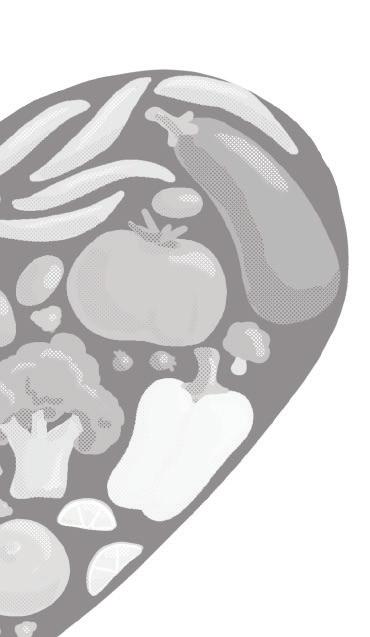
On Cooking, Loving and Learning to Live
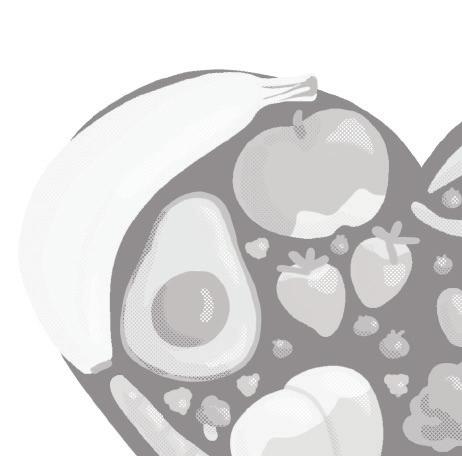
// BY MAIA DECKER


// SOPHIE HENRY
My new apartment has a small kitchen with a large window. Being in the heart of a mountain town in Montana, one can imagine the summits that would be visible if not for the brick wall adjacent. The counter is covered with an amalgamation of life: small succulents propagating on a plate, fruit nearly spilling out their glass bowl and halfempty glasses. My roommates and I tricked ourselves into believing some of the kitchen’s objects are essential; do all adults need jars for flour, sugar and rice? It is in this space that we’re becoming the versions of ourselves we need to be. While cooking for each other, we’re growing up.
When my sister and I were young, our parents insisted that we learn how to cook with them. When my mother made Indian food from her favorite now-closed restaurant, our little hands folded samosas and stirred dal. “One day you’ll live on your own,” she insisted. “You should know how to feed yourself.” My father would tell stories of not knowing how to cook rice in college, and we’d all laugh. Among all other things, teaching us how to make food was my parents’ way of preparing us to live.
The older I grew, the more I became myself through cooking. In high school, my best friend and I would make pasta together while backpacking; in the morning, we ate oatmeal while the sun refl ected of the lake, hitting our tent and bundled up faces. In our own homes, we’d make garlic knots that turned into warped orbs. “No matter,” we would cry! Both attentive in school, we learned through cooking that perfection was a false stage that we’d painted for ourselves. We could make mistakes and the world would continue turning.
Eventually, the oldest of my friends started moving into apartments with kitchens of their own. There, we would all cook together. One person would make a salad, ripe with tomatoes from their garden. Others told stories about school while dicing sweet potatoes and chopping rosemary. In the summer heat, far behind schedule, we’d all eat. Around second-hand tables, we learned to listen attentively to each other. One person’s silence often meant they were mulling over a fear. Then, we would go for a walk later, the moonlight soothing worry and the words “I love you” being of ered as dessert.
When I left for school in the fall, I knew that, of all things, I would miss the people from home the most. While I was gone, we would have group calls and I would imagine how beautiful their faces once looked around a table. How their laughs sounded distant not just because of the thousands of miles they had to travel, but also because they weren’t echoing above our slightly chipped dinner plates. We entered adulthood together, and there we were, all trying to live out in the world without each other.
The fi rst night I moved into my new apartment with my closest friends from home, we cooked dinner. The night, like many others, was documented with polaroids pinned to the corkboard that guards our front door — our smiling faces welcome us each time we hang our coats.
We have an eclectic group of roommates featured on the board, each studying something vastly dif erent: astrophysics, wildlife biology, piano performance and humanities. Some nights in our small apartment, Rachmaninoff’s intricate melodies will travel through the halls, teaching us unspoken wisdom, as the rest of us spin tales of our own lessons we have gained thus far in life.
“Use the knife like this to avoid cutting yourself,” we whisper, telling each other how to protect ourselves.
“You can tell the oil is hot this way,” one roommate will say, noting the moment when it is time to denounce fear and begin doing what needs to be done.
“These spices go well together,” another announces while stirring sauce and teaching us about balance.
We have all made many mistakes in the kitchen. Once, the apartment filled with the smoke from burnt cookies. Last week, I sliced my hand open cutting carrots. Quite often, food will start to go bad in the fridge as we cling to the past. Throw the old milk out, it’s a new week.
At the end of each day, we are all still confused at how fast life has pulled us into adulthood. We all have to do things like pay bills, feed the cat and decide what it is we want to do with all the living that remains. Still, we have our meals as a place of comfort.
Our hands are always busy. Playing études. Noting the joints of a bird’s wing. Mapping out the universe. Writing in books. Cutting vegetables. Washing dishes. Holding each other.
Despite what may come, we will always have to eat. Just as with all other special moments, the beauty is amplifi ed when we are together.
Contact MAIA DECKER at maia.decker@yale.edu .
WKND RECOMMENDS
Squishmallows.

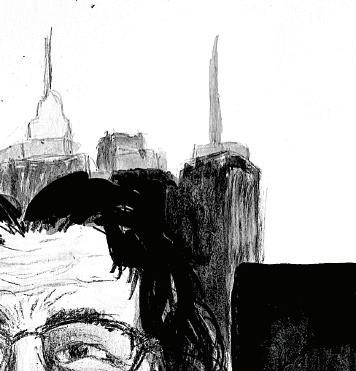



It’s your fi rst time in New York City. Perhaps you’ve come here by plane or train, saving up for the trip and making a list of places to visit. You’ve seen the photographs, but now you are finally strolling through the Capital of the World. Around Midtown, you pause in the street to gawk at the glassy towers and the bright shops beneath them. People fl y in and out of mustard taxi cabs, shifty-eyed and deliberate as they ignore you.
Except one.
“Move along!” Fran Lebowitz yells at you. “Pretend it’s a city!”
Cultural critic Fran Lebowitz made her streaming show debut last month with Netflix’s “Pretend It’s a City.” The seven-episode documentary series is directed by her longtime friend Martin Scorsese. It is a show about New York,
Pretend It’s a Review
// BY MARGOT LEE
// SOPHIA DESCHIFFART
but even more than that, it’s about Fran Lebowitz. She is the true subject in a three-and-a-half-hour interview grouped around topics such as the city, art, transport, money, sports and books.
I didn’t know much about Lebowitz before watching the docuseries. But for days after watching the show, I felt as though she lived inside my mind. Lebowitz is a unique character, but she certainly falls into the type of the esoteric New York grouch. She is a humorist with a no-nonsense attitude, which makes her a delightful curmudgeon as she delivers each witty, stinging criticism of society. She isn’t a comedian; she isn’t searching to set up some punchline. She is Larry David-esque in her grievances, but less playful and with a little more snark. There’s a frustration and political edge to her opinions. “I cannot stand my fellow man,” Lebowitz declares.
She is a writer, although her last published work was a children’s book in 1994. Before that, her two books of comedic essays on culture and her life — “Metropolitan Life” (1978) and “Social Studies” (1981) — were bestsellers. In the ’70s, she wrote for Andy Warhol’s Interview magazine with a column titled “I Cover the Waterfront.” She has been the subject of a Scorsese documentary once before in “Public Speaking” (2010), and “Pretend It’s a City” seems like an excuse to hear more from Lebowitz, whose content nowadays is scarce.
“Pretend It’s a City” is a niche show and a hard sell. I didn’t quite know how to pin down the docuseries. It is about Lebowitz, but at moments, it is more interested in her stories than her life.
I could describe the show in several ways. Here is a sampling:
Sardonic writer delivers a scathing takedown of the modern world in an interview with a Hollywood director.
Two artists gallivant around Manhattan and look at landmarks such as: Grand Central Terminal, the Wall Street Bull, the Chrysler Building, Times Square (“the worst neighborhood in the world”), etc.
A wistful reminiscence of a bygone bohemian era of New York from two icons who lived through it.
Humorist observes the actions of people and passes judgement.
There is no real arc to the show but somehow, Scorsese connects it all. Archived footage and visual aides help move from one anecdote, one quip, to the next as though it were a natural conversation. The images recall a cultural and artistic New York of the ’60s and ’70s. Scorsese’s interest in this era is a trait of his documentary work — passion projects that run concurrently with his fi lms — particularly his music documentaries. Like tour footage of George Harrison, Bob Dylan and the Rolling Stones, Scorsese arranges Lebowitz’s dialogue in the way he arranges a concert.
And this is a concert — a Fran Lebowitz concert. Like a musician rif ng, she receives audience and interview questions without missing a beat, and can talk about any subject at length.
Her opinions are the music of the show. For many minutes, we hear about the problems of Times Square and the $40 million spent on repaving the islands so that tourists can lie down in lawn chairs. Lebowitz questions the closing of subway stations to install mosaics of Weimaraner dogs in clothing. She cannot tolerate the obsession with “wellness” and wants to smoke on planes. She is outraged by the state of things.
In the 2000s, Lebowitz played a judge in a few sporadic episodes of “Law and Order.” She had a similar cameo in Scorsese’s “The Wolf of Wall Street” (2013). It’s a fi tting role for Lebowitz, up on the bench with her dark gown and gavel, looking disapprovingly at her fellow citizens and setting bails.
To some, Lebowitz’s opinions might be overbearing and snobbish. She is uncompromising. David Letterman interviewed Lebowitz in 1980, asking if she could form a group of others with similar disturbances. Her response was: “Unfortunately, there are no people with similar disturbances.”
Lebowitz herself cannot understand viewers irritated by her opinions as she has no real power to enforce them. “If I could change it, I wouldn’t be so angry,” Lebowitz explains in the series. “The anger is, I have no power, but I’m fi lled with opinions.”
So what is the point of this show?
You might not agree with all of Lebowitz’s opinions. I certainly didn’t. But I am a fan of grouchiness and had a ridiculous amount of fun listening to Lebowitz. Apart from being searingly witty, she is the ultimate fl aneur. She has been the eyewitness to New York for decades. The series has a fanciful nostalgia for an older New York — one where Lebowitz roamed the streets barefoot, eating breakfast in diners with jazz legends and visiting clubs that no longer exist.
While commenting on all aspects of life that have changed, Lebowitz herself is the antithesis of change. She is a luddite without a computer or a cellphone, which gives her the time to watch the world. For years, she has adopted a constant uniform. A navy men’s suit jacket, Levi’s, cowboy boots and dark circular sunglasses make her instantly recognizable on the streets of New York. She dons an oversized coat in “Pretend It’s a City” and becomes a hulking rectangle. She has been a smoker since a young age.
In a city where nothing is permanent, there is something comforting about an icon who doesn’t change. As long as there are people who get annoyed and complain about trivial things, there is a sanity to the world. It’s a little indulgent, for both Scorsese and the viewer, but there is a joy to watching Lebowitz and Scorsese shuffl e around New York and chuckle together. As Lebowitz urges, “Any fun you can have, friend, go ahead.”
You may as well have fun with it, since Lebowitz can’t. She doesn’t have Netfl ix.
Contact MARGOT LEE at margot.lee@yale.edu .
The Girl From Magnolia Street // BY KATE WILLIAMS
Love. It is indescribable and unpredictable. It is peaceful and frantic, beautiful and painful, happy and sad, easy and hard. It is both the lightning that strikes during the storm and the rainbow at the end of it. Love is, well, love.
I’m no expert on love. Then again, no one is. Love means dif erent things for everyone. Some call it fate or destiny, while others call it hard work and patience. All I know is that I have been lucky enough to experience it. In fact, I have already had the greatest love of my life.
I can’t pinpoint exactly when it happened, but even in my earliest memories of my mother, I knew it was love. At fi rst, it was the little things that made me know. When we would bake together and I would inevitably end up with frosting smeared across my face and the kitchen covered in fl our. When we would spend hours together playing Just Dance on the Wii, failing miserably at hitting the right moves, but succeeding in laughing so relentlessly that we’d fi nd our abs sore the next day. I could sit on the couch with her in silence and still be the happiest I have ever been in my entire life.
The pure happiness and relief I felt when I saw her was unmatched. No matter what had happened she would never fail to melt my worries away. A smile or laugh from her was contagious, the best cure in the world. There was always this sense of security and contentment with her, a sense that I could not get from anyone else.
As I matured, I began to understand how thoughtful and compassionate she was. Every argument or fi ght always ended with her apologizing first, even when I was in the wrong. Once, we had a heated debate about her belief in the superiority of waf es. It ended with a homemade stack of pancakes in front of me, a peace of ering, even though we both knew she was right about the true winner. I stopped taking everything she did for me for granted. She sacrifi ced everything for me: her mind, body and soul.
I was constantly in awe of her. The way she captured a room every time she walked into it. No matter how many people were there, the world stopped. It wasn’t because she wanted all eyes on her, but because she had her eyes on everyone else. She was always able to make people feel like they were the only person in the universe — that they were heard and important. And the thing is, to her, they truly were. She never forgot a story or the face that went with it. Everyone, even the construction worker paving the grocery store parking lot knew her name because she knew theirs.
One night we were watching the Oscars together, and the in memoriam part of the show came on. An intense feeling of dread washed over me. I had never really thought about death, or what it meant. I asked her what she thought happened when someone died. She said she didn’t know.
I felt a tightness in my chest — a response to the newfound panic in my head. Not because I found dying scary, but because the idea of losing my mother was unimaginable. I couldn’t even begin to think of a life without her. That is when I truly realized what she meant to me. I loved her with every fi ber of my being.
The thing about love is that with it comes heartbreak. The greatest love of my life was my mom. She passed away a few years ago. It was heartbreaking. The kind that never really heals.
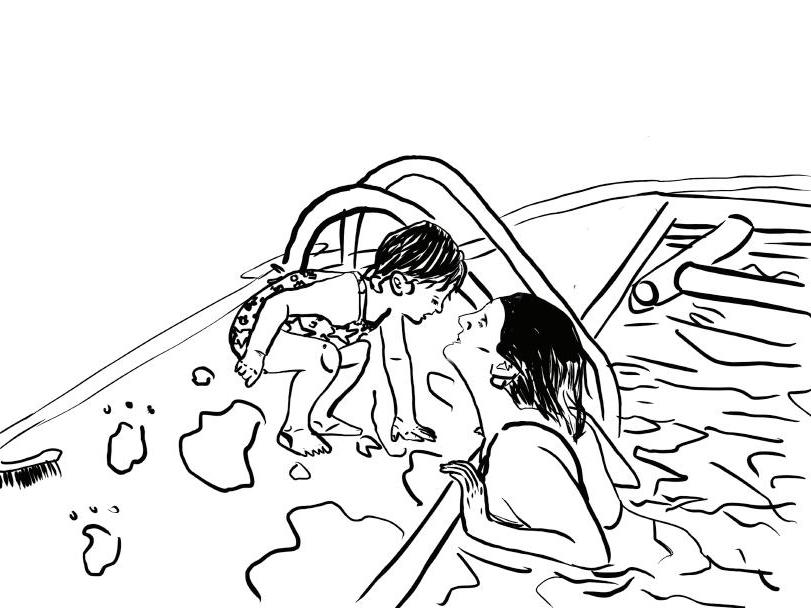
My mom grew up in Neptune Beach, Florida, right on the water. A year before she passed, we took a mother-daughter trip down there to help pack up my grandmama’s house. After a couple of long days that involved lots of cardboard boxes and trips to Goodwill, we decided to take a breather and go for a walk on the beach. We walked along the sand looking for shells and time got away from us. A snap of cold February water hit my feet as high tide met them. I let out a squeal and ran up towards the boardwalk, looking over my shoulder at the water chasing me.
I saw my mom standing in the same exact position I had left her in, and watched her let the saltwater pool around her feet. I saw a glimmer in her eye and the corners of her mouth started to turn up. I knew what was coming. She turned on her heel and ran straight into the ocean, fully clothed, laughing and splashing as if she were a child once more.
“Chicken!” she called back at me. “You’re not scared, are you?” she said, facetiously. I looked down at my long sleeve T-shirt and jeans, mentally preparing myself for what I was about to do. I sprinted towards her, clenching my teeth when the water hit every part of my body all at once.
We spent time diving under and fl oating over waves as they came to us. Years before, she had taught me how to read approaching waves at the very same spot. I remembered being scared to dive through the big ones at fi rst. Eventually I had gotten up the courage to try. Somehow, all of those years later, I still remembered what she had said: “You know, most of the things I love in life start out a little bit scary.”
I told her she’d said this as we were walking back up the boardwalk on Magnolia Street, soaking wet. She cracked a joke about how wise she was, but then she stopped and looked at me a little more seriously. A warm breeze swept her hair away as it touched her face, revealing the gold speckles in her blue eyes, “What I said is true, though. And, in your heart of hearts, you will never run out of love to give. Especially, if you’ve learned how to love to live.”
I loved her more than anyone else in the entire world, and I still do. After losing her I didn’t think I would ever love so deeply again.
Until I did. I don’t know if it was destiny or fate. The best way that I have found to describe it is through a Japanese term, “Koi No Yokan.” This phrase — dif cult to translate into English — represents the feeling upon meeting someone that you will inevitably fall in love with them.
I know she would have loved him. In fact, sometimes he reminds me of her. The way that he is always able to make me laugh and how people always like him. The way that he feels the need to always be okay so that everyone else is. The way I can see through his eyes into his soul, and how brilliant his mind is. I even hear her in his appreciation of little things in life, like the beauty of a bright yet unawake morning or the peace in untouched snow.
It isn’t just in him. I see her in my brother’s smile and my sister’s walk. My cousin has her sense of humor and my uncle, her wisdom. I sense her in one of my best friend’s thoughts and in the twinkle of the other’s eyes. I think of her when I hear the rush of the ocean, look out at a breathtaking view from the peak of a mountain or laugh at the stars above.
I believe, through her, I’ve begun to learn how to love to live. For me, that has come in the form of living to love. When my mom died, all that was left of her was a whole lot of love. So I take that love she left me and I give it away as much as I can because I know that’s what she would have wanted.
I don’t know what exactly love is. But I know how it feels, and I know that it’s out there. It can be scary sometimes, but then again most of the best things in life are. I know that there is always more love in this world, if we can only fi nd it in our hearts of hearts to give.
Contact KATE WILLIAMS at kate.williams@yale.edu .
// KALINA MLADENOVA
WKND RECOMMENDS
Edgerton Park.






